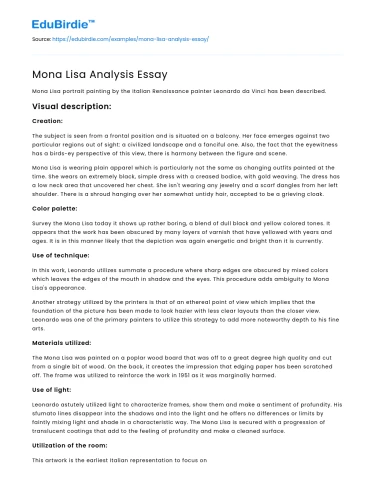Mona Lisa portrait painting by the Italian Renaissance painter Leonardo da Vinci has been described.
Visual description:
Creation:
The subject is seen from a frontal position and is situated on a balcony. Her face emerges against two particular regions out of sight: a civilized landscape and a fanciful one. Also, the fact that the eyewitness has a birds-ey perspective of this view, there is harmony between the figure and scene.
Save your time!
We can take care of your essay
- Proper editing and formatting
- Free revision, title page, and bibliography
- Flexible prices and money-back guarantee
Mona Lisa is wearing plain apparel which is particularly not the same as changing outfits painted at the time. She wears an extremely black, simple dress with a creased bodice, with gold weaving. The dress has a low neck area that uncovered her chest. She isn't wearing any jewelry and a scarf dangles from her left shoulder. There is a shroud hanging over her somewhat untidy hair, accepted to be a grieving cloak.
Color palette:
Survey the Mona Lisa today it shows up rather boring, a blend of dull black and yellow colored tones. It appears that the work has been obscured by many layers of varnish that have yellowed with years and ages. It is in this manner likely that the depiction was again energetic and bright than it is currently.
Use of technique:
In this work, Leonardo utilizes summate a procedure where sharp edges are obscured by mixed colors which leaves the edges of the mouth in shadow and the eyes. This procedure adds ambiguity to Mona Lisa's appearance.
Another strategy utilized by the printers is that of an ethereal point of view which implies that the foundation of the picture has been made to look hazier with less clear layouts than the closer view. Leonardo was one of the primary painters to utilize this strategy to add more noteworthy depth to his fine arts.
Materials utilized:
The Mona Lisa was painted on a poplar wood board that was off to a great degree high quality and cut from a single bit of wood. On the back, it creates the impression that edging paper has been scratched off. The frame was utilized to reinforce the work in 1951 as it was marginally harmed.
Use of light:
Leonardo astutely utilized light to characterize frames, show them and make a sentiment of profundity. His sfumato lines disappear into the shadows and into the light and he offers no differences or limits by faintly mixing light and shade in a characteristic way. The Mona Lisa is secured with a progression of translucent coatings that add to the feeling of profundity and make a cleaned surface.
Utilization of the room:
This artwork is the earliest Italian representation to focus on the sitter in a half-length delineation. Its huge measurements imply that it incorporates the arms and hands without them






 Stuck on your essay?
Stuck on your essay?

